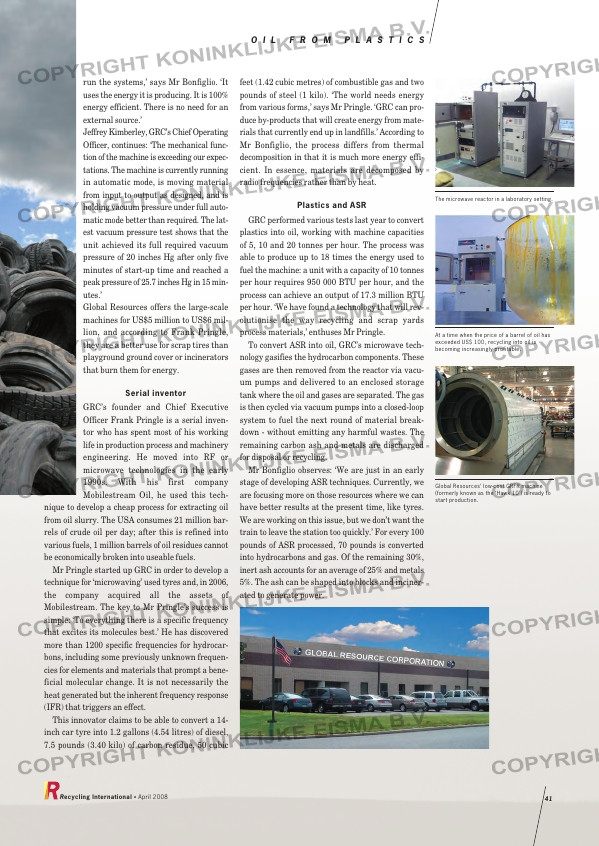Page 41 from: April 2008

run the systems,’ says Mr Bonfiglio. ‘It
uses the energy it is producing. It is 100%
energy efficient. There is no need for an
external source.’
Jeffrey Kimberley, GRC’s Chief Operating
Officer, continues: ‘The mechanical func-
tion of the machine is exceeding our expec-
tations. The machine is currently running
in automatic mode, is moving material
from input to output as designed, and is
holding vacuum pressure under full auto-
matic mode better than required. The lat-
est vacuum pressure test shows that the
unit achieved its full required vacuum
pressure of 20 inches Hg after only five
minutes of start-up time and reached a
peak pressure of 25.7 inches Hg in 15 min-
utes.’
Global Resources offers the large-scale
machines for US$5 million to US$6 mil-
lion, and according to Frank Pringle,
they are a better use for scrap tires than
playground ground cover or incinerators
that burn them for energy.
Serial inventor
GRC’s founder and Chief Executive
Officer Frank Pringle is a serial inven-
tor who has spent most of his working
life in production process and machinery
engineering. He moved into RF or
microwave technologies in the early
1990s. With his first company
Mobilestream Oil, he used this tech-
nique to develop a cheap process for extracting oil
from oil slurry. The USA consumes 21 million bar-
rels of crude oil per day; after this is refined into
various fuels, 1 million barrels of oil residues cannot
be economically broken into useable fuels.
Mr Pringle started up GRC in order to develop a
technique for ‘microwaving’ used tyres and, in 2006,
the company acquired all the assets of
Mobilestream. The key to Mr Pringle’s success is
simple: ‘To everything there is a specific frequency
that excites its molecules best.’ He has discovered
more than 1200 specific frequencies for hydrocar-
bons, including some previously unknown frequen-
cies for elements and materials that prompt a bene-
ficial molecular change. It is not necessarily the
heat generated but the inherent frequency response
(IFR) that triggers an effect.
This innovator claims to be able to convert a 14-
inch car tyre into 1.2 gallons (4.54 litres) of diesel,
7.5 pounds (3.40 kilo) of carbon residue, 50 cubic
feet (1.42 cubic metres) of combustible gas and two
pounds of steel (1 kilo). ‘The world needs energy
from various forms,’ says Mr Pringle. ‘GRC can pro-
duce by-products that will create energy from mate-
rials that currently end up in landfills.’ According to
Mr Bonfiglio, the process differs from thermal
decomposition in that it is much more energy effi-
cient. In essence, materials are decomposed by
radio frequencies rather than by heat.
Plastics and ASR
GRC performed various tests last year to convert
plastics into oil, working with machine capacities
of 5, 10 and 20 tonnes per hour. The process was
able to produce up to 18 times the energy used to
fuel the machine: a unit with a capacity of 10 tonnes
per hour requires 950 000 BTU per hour, and the
process can achieve an output of 17.3 million BTU
per hour. ‘We have found a technology that will rev-
olutionise the way recycling and scrap yards
process materials,’ enthuses Mr Pringle.
To convert ASR into oil, GRC’s microwave tech-
nology gasifies the hydrocarbon components. These
gases are then removed from the reactor via vacu-
um pumps and delivered to an enclosed storage
tank where the oil and gases are separated. The gas
is then cycled via vacuum pumps into a closed-loop
system to fuel the next round of material break-
down – without emitting any harmful wastes. The
remaining carbon ash and metals are discharged
for disposal or recycling.
Mr Bonfiglio observes: ‘We are just in an early
stage of developing ASR techniques. Currently, we
are focusing more on those resources where we can
have better results at the present time, like tyres.
We are working on this issue, but we don’t want the
train to leave the station too quickly.’ For every 100
pounds of ASR processed , 70 pounds is converted
into hydrocarbons and gas. Of the remaining 30%,
inert ash accounts for an average of 25% and metals
5%. The ash can be shaped into blocks and inciner-
ated to generate power.
O I L F R O M P L A S T I C S
Recycling International • April 2008 41
Global Resources’ low-cost GRFR machine
(formerly known as the ‘Hawk 10’) is ready to
start production.
At a time when the price of a barrel of oil has
exceeded US$ 100, recycling into oil is
becoming increasingly profitable.
The microwave reactor in a laboratory setting.
RI_052 OIL plastic:Opmaak 1 04-04-2008 08:58 Pagina 41



